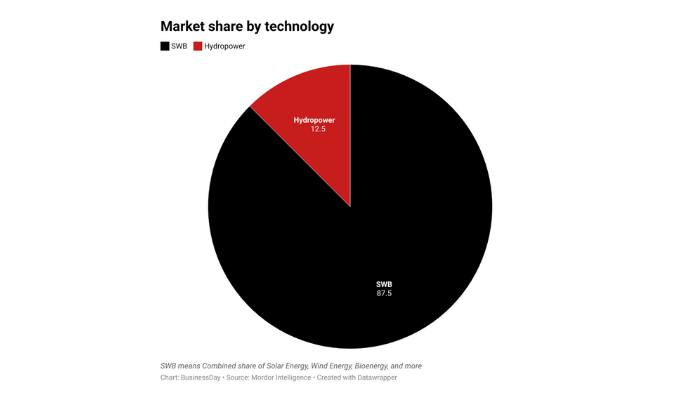For years, Nigeria’s power story was one of scarcity and strain. Generators filled the silence left by the national grid, and diesel became the lifeblood of commerce. Today, that dependence is flipping into an investment boom. Renewable energy, once dismissed as idealistic, is fast becoming Nigeria’s most bankable asset class.
From crisis to cash flow
The end of fuel subsidies in 2023, though painful, has changed the arithmetic of energy. With diesel prices above N1,100 per litre, self-generation is no longer sustainable for households or manufacturers. Solar, hybrid, and mini-grid systems now deliver cheaper, cleaner electricity at predictable prices.
According to the Rocky Mountain Institute, in 2025, about 22 million Nigerian homes remain off-grid, representing a potential 20-billion-dollar investment gap. The federal government’s Energy Transition Plan 2060, supported by the World Bank and United Nations, aims for renewables to supply 30 percent of national electricity by 2030.
The Financial Reporting Council has also introduced a sustainability roadmap based on IFRS S2, which will require listed companies to disclose carbon exposure. Firms that cut emissions may now enjoy lower borrowing costs as banks integrate environmental performance into credit pricing.
Capital chases credibility.
Policy consistency is drawing real money. Development finance is deepening at home and across the off-grid segment. The Nigeria Electrification Project and InfraCredit’s guarantees have improved bankability for local developers. IFC has financed operators active in Nigeria, such as Daystar Power and Husk Power, while Norfund has backed Nigeria-based platforms, including Konexa.
In 2024, the European Investment Bank approved a $20m facility for Husk Nigeria to expand rural solar networks. At home, Access Bank and Sterling Bank have launched green-loan products tied to verified carbon savings, channeling local credit into clean-energy projects.
According to project data compiled by the African Development Bank, mini-grid developers report internal rates of return between 16 and 22 percent, outpacing most sectors even with a 27 percent policy rate.
Mid-sized manufacturers using solar hybrids have reduced energy costs by as much as 40 percent. For investors balancing yield and ESG mandates, Nigeria’s renewable segment now offers both.
Read also: Why Nigeria must seize multi-trillion-dollar renewable opportunities
Where the smart money flows
The opportunity extends well beyond generation.
Battery storage and recycling: Ogun State is leading Nigeria’s emerging battery ecosystem. A lithium-ion battery recycling facility supported by Innovate UK Business Connect is already operating in Abeokuta, reducing import dependence and anchoring a domestic clean-tech supply chain. Other states, including Anambra, are exploring partnerships to attract pack-assembly investment.
Commercial and industrial solar: Power-as-a- Service contracts are scaling across Lagos and the Sagamu industrial corridor. Developers such as Daystar Power and Starsight Energy are signing multi-year deals with factories and estates, guaranteeing steady tariffs and cutting diesel reliance for clients.
Green hydrogen and ammonia pilots: According to technical assessments by the International Finance Corporation and Nigeria’s Ministry of Power, early-stage studies are mapping Nigeria’s potential for green hydrogen and ammonia production from the Niger Delta. These projects aim to serve Europe’s decarbonising industries once export infrastructure matures.
These ventures combine dollar-linked or inflation-indexed revenues with resilient domestic demand, a mix that continues to attract infrastructure and private-equity investors seeking predictable, long-duration returns.
Tailwinds, hurdles and the policy runway
Grid instability still limits feed-in options, foreign-exchange volatility inflates equipment costs, and enforcement of power-purchase agreements remains uneven. The pending Renewable Energy Bill 2026 aims to harmonise tariffs, licensing, and guarantees, a move analysts say could unlock billions of dollars in delayed projects.
The government’s Solar Naija initiative is also retooling idle industrial parks for local production of frames, inverters, and charge controllers. If successful, developers estimate capital costs could fall by 10 to 15 percent while creating thousands of manufacturing jobs.
Read also: Nigeria likely to review Capital Gains Tax, Edun says
The macro logic of green
Every new megawatt of reliable renewable power reduces Nigeria’s exposure to imported diesel and FX leakage, and it lifts productivity by cutting outages and generator costs, according to climate-finance analyses. Localising more of the supply chain would further ease trade-deficit pressure.
Corporate energy use is shifting. Tower operators such as IHS Towers are rolling out solar and battery hybrids across thousands of sites, reporting sizable reductions in diesel consumption; new partnerships are adding hundreds more solarised locations.
Cement producers are investing in decarbonisation through alternative fuels, captive power upgrades and lower-carbon products, with Lafarge Africa publicly detailing kiln efficiency and low-carbon concrete initiatives. On the finance side, Nigeria’s sovereign green bonds have scaled, with the 2025 issuance raising N47.4bn for eligible climate projects.
Each locally generated watt helps firms hedge currency risk. And for exporters, the EU’s Carbon Border Adjustment Mechanism means carbon intensity will carry a price in Europe for sectors such as cement and steel, making cleaner energy a competitiveness issue as much as a climate one.
Mapping the opportunity
Northern states, from Kano to Maiduguri, offer the highest solar and wind yields of 5.5 to 6.5 kWh/m²/day, according to the Federal Ministry of Power’s National Renewable Resource Atlas.
Lagos, under its 2024 electricity law, has become the capital of distributed generation. Middle-belt states such as Plateau and Benue blend solar and bioenergy mini-grids to power agro-processors, while Niger Delta industries integrate renewables into refineries and export terminals to earn flare-gas credits.
State-level incentives vary, but investor sentiment is strongest where energy boards provide clear interconnection guidelines and access to land.

